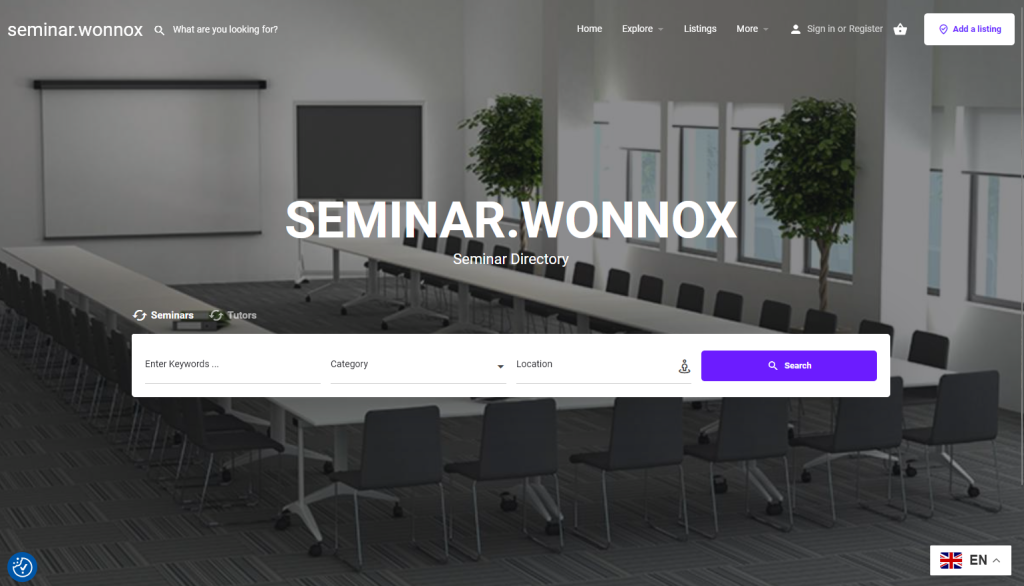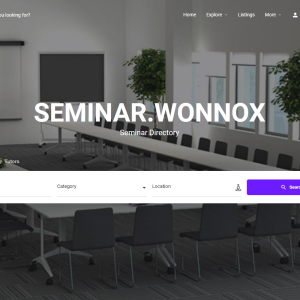
- Direct message
- Leave a review
- Bookmark
- Share
- Report
- prev
- next
Description
Creating a comprehensive seminar listing or profile in a web directory requires several key features that ensure clarity, appeal, and usefulness for potential attendees. A well-structured listing can significantly enhance visibility and engagement, making it easier for users to understand what the seminar offers, how to participate, and why it might be valuable to them. Here is an in-depth breakdown of the features to include, covering all critical elements of a seminar listing or profile in a web directory:
1. Basic Information
Seminar Title: A concise and descriptive title that reflects the main focus of the seminar. This should be attention-grabbing and informative, giving potential attendees a clear idea of the topic.
Date and Time: Clearly state the date(s) and time of the seminar, including time zone information for virtual events. This ensures that attendees from different regions can plan accordingly.
Duration: Mention the length of the seminar (e.g., two hours, half-day, full-day). This helps attendees manage their schedules.
2. Location Details
Physical Location: If the seminar is in-person, include the full address with city, state, and postal code. Provide information about the venue (e.g., conference hall, hotel, or university).
Virtual Option: For online seminars, include the platform details (e.g., Zoom, Microsoft Teams, Google Meet). Provide a link for joining the seminar or details on how the link will be shared with registered participants.
Hybrid Option: If the seminar is offered both in-person and online, clearly describe both options and how participants can choose their preferred mode.
3. Overview/Description
Brief Description: A short paragraph (50-100 words) summarizing the seminar's core theme or purpose. This should outline the value or benefit of attending.
Detailed Description: A more extensive overview (200-300 words) detailing the content, goals, and structure of the seminar. This can include topics covered, methods of delivery (lectures, workshops, group discussions), and any specific skills or knowledge participants can expect to gain.
Learning Outcomes: List the key takeaways or outcomes that attendees will gain from the seminar. This helps potential attendees assess whether the seminar aligns with their interests or professional needs.
4. Speaker Information
Speaker Profile: Include details about the seminar speaker(s) or presenter(s), such as their name, title, and professional background. This should highlight their expertise and why they are qualified to lead the seminar.
Speaker Photo: Adding a professional photo of the speaker adds a personal touch and makes the listing more engaging.
Previous Experience: Mention any notable past seminars or achievements of the speaker. This helps build credibility and trust.
5. Target Audience
Audience Description: Define who the seminar is intended for (e.g., students, professionals, entrepreneurs, hobbyists). Clarifying the target audience helps attract the right attendees.
Prerequisites: Specify if any prior knowledge or skills are required to attend the seminar. For example, if it's an advanced technical seminar, make sure to mention that some basic knowledge of the subject is expected.
Level of the Seminar: Indicate whether the seminar is designed for beginners, intermediate learners, or advanced participants. This will help users quickly determine if the content matches their experience level.
6. Registration Details
Registration Process: Clearly explain how to register for the seminar, including whether it's through a form, email, or an external website. Include a “Register Now” button for quick access if possible.
Registration Deadline: Mention the last date to register for the seminar, especially if there is limited seating or if pre-registration is required.
Cost/Fees: State the price of the seminar, including any early bird discounts, group rates, or special offers. If the seminar is free, mention this clearly as it can be a significant draw for potential attendees.
Payment Options: Provide details on how participants can pay for the seminar, such as through credit cards, PayPal, or bank transfers. Secure payment options should be highlighted for user trust.
7. Agenda and Schedule
Agenda Overview: Include a schedule of events, such as start time, breaks, and the end time. If the seminar is divided into sessions, list each session with its respective time slot.
Session Details: Briefly describe each session or topic that will be covered, along with the names of the speakers for each session if there are multiple presenters.
Break Times: Mention any scheduled breaks, including lunch or networking opportunities, as this can be important for participants planning their day.
8. Interactive Elements
Q&A Sessions: If there will be time allocated for questions and answers, mention this in the listing. It adds value for participants looking for direct interaction with experts.
Networking Opportunities: For in-person or virtual seminars, highlight any opportunities for networking, such as breakout rooms, group discussions, or post-seminar meetups.
Resource Materials: List any materials participants will receive, such as handouts, slides, access to a recording, or supplementary resources. This adds perceived value to the seminar.
9. Visual and Media Content
Banner Image: A visually appealing banner image related to the seminar’s topic can make the listing more attractive. Ensure that it is high quality and relevant to the theme.
Introductory Video: A short video (1-2 minutes) from the speaker or a promotional video can help convey the seminar's value and set the tone. It can also give a sense of the speaker’s style and energy.
Images of Past Events: If the seminar is recurring or similar events have been hosted previously, include images from past seminars to build credibility and show what attendees can expect.
10. Contact Information
Organizer Details: Include the name and contact details (phone number, email) of the organizing person or entity. This helps users reach out with any questions or special requirements.
Support Contact: For virtual seminars, provide a contact for technical support in case participants face issues with the platform.
Social Media Links: Provide links to the organizer’s social media pages or the seminar’s event page on platforms like Facebook, LinkedIn, or Instagram for further engagement.
11. Testimonials and Reviews
Past Attendee Feedback: If available, include testimonials or reviews from participants of previous seminars. Positive feedback can help build trust and attract new attendees.
Ratings: Allow users to rate the seminar or leave comments directly on the directory page if the platform supports it. This can be a great way for potential attendees to gauge the quality of the event.
12. SEO-Friendly Content
Keywords: Use relevant keywords in the title and description to improve the seminar’s visibility in search engine results. Focus on terms that potential attendees might use to search for such events.
Meta Description: Write a concise meta description (about 150-160 characters) that summarizes the seminar. This is often displayed in search engine results and can help attract clicks.
Tags and Categories: Include tags that align with the seminar’s subject matter (e.g., “business seminar,” “leadership training,” “digital marketing workshop”). These help users find the seminar through directory searches.
13. Follow-up and Feedback
Feedback Form: Mention that participants will receive a feedback form after the seminar. This shows that the organizers are committed to improvement and value attendees' opinions.
Certificate of Attendance: If a certificate is offered, highlight this feature. Certificates can be valuable for participants who want to demonstrate professional development.
Follow-up Resources: Mention any post-seminar follow-ups, such as access to recorded sessions, downloadable materials, or future related seminars.
14. Call to Action (CTA)
Encouraging CTA: Include a clear and motivating call-to-action, such as “Reserve Your Spot Now,” “Join Us for a Transformative Experience,” or “Sign Up for Exclusive Insights.” A well-crafted CTA can greatly improve conversion rates.
Limited Seats Warning: If seats are limited, highlighting this can create a sense of urgency, prompting users to register sooner rather than later.
Conclusion:
A well-rounded seminar listing or profile should combine all these elements to effectively inform and engage potential attendees. It must be both informative and visually appealing, offering users all the necessary information while also providing incentives to register. By including details like an engaging description, comprehensive schedule, and clear registration instructions, organizers can ensure their seminar stands out in a competitive web directory. This holistic approach makes the seminar more discoverable, attractive, and ultimately, successful in drawing in the right audience.

Add a review